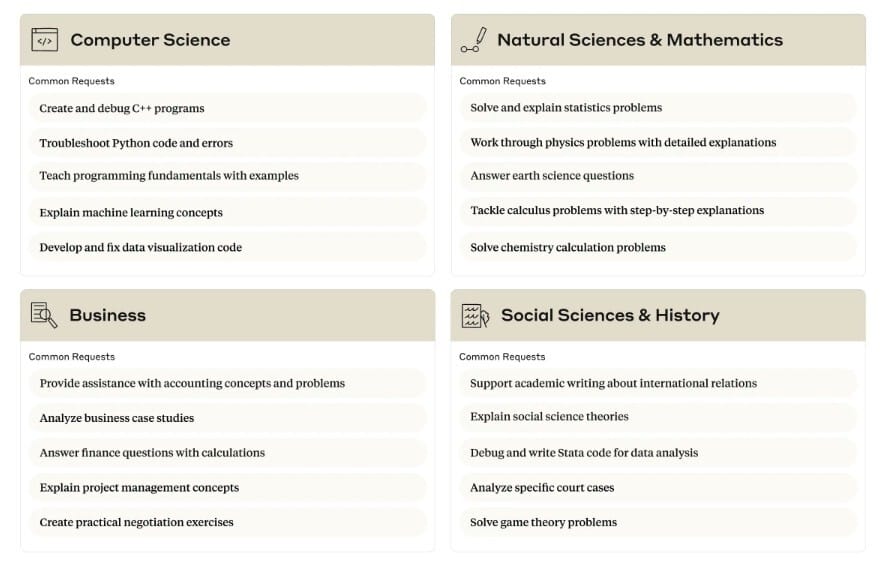OpenAI just dropped GPT-4.1, and it’s smarter, faster, and better at code—but there’s one big problem: it’s API only. Meanwhile, U.S. college students are all-in on AI (even if their schools aren’t), and this week’s challenge will help you automate your daily brainpower. Let’s jump in ⬇️
In today’s newsletter:
🔐 GPT-4.1 delivers in some ways and disappoints in others
📚 College students are using AI to fill the classroom gaps
🕶️ ByteDance is working on AI-powered smart glasses
🧠 Challenge of the Week: Automate your thinking with GPT Tasks
📈 So What’s New in GPT-4.1?
OpenAI has launched GPT-4.1—its smartest and most efficient non-reasoning version yet. It builds on 4o with better reasoning, fewer hallucinations, and superior performance in coding, especially code review and documentation. It's also more latency-efficient and handles longer context windows more reliably.
There are multiple tiers: GPT-4.1, 4.1 Mini, and 4.1 Nano. Benchmarks from early users suggest it's already outperforming many popular paid models—particularly when it comes to logic-heavy tasks and programming reliability.
Want to dive deeper into the details?
📑 Check out the official GPT 4.1 release video from OpenAI here
⚙️ Where can you use it?
Here’s the twist: GPT-4.1 is available now—but only through OpenAI’s API. That means if you’re using GPT via tools like ChatGPT’s web interface (even on Plus), you likely don’t have access to the new model yet. API users and enterprise developers, on the other hand, can tap into its full capabilities immediately. Currently, you can use GPT-4.1 on:
And many others
This rollout strategy reflects OpenAI’s growing shift toward commercial-first access. It’s faster for businesses, but it leaves many individuals wondering when they’ll get their hands on the best version.
🔍 Why this matters
GPT-4.1 introduces major improvements that could streamline coding, writing, and long-form thinking workflows. But there’s an important caveat: it may not even be OpenAI’s best model.
While it does outperform GPT-4-turbo in some coding benchmarks, developers have noted that in general usage—especially for creative tasks—it's more of an efficiency update than a leap forward. It's optimized for structured logic, but less impressive for nuanced reasoning or storytelling.
As more of OpenAI’s releases get gated behind API access and enterprise tiers, the future of “public AI” may look increasingly fragmented—with specialized models tuned for specific contexts, and fewer general-purpose updates available to everyday users.
If you're a developer, it's a win. But for the rest of us? It's a glimpse into a future where AI capability isn't just about innovation—it's about access.
📚 College Students Are Using AI to Fill the Classroom Gaps
🎓 A silent revolution in the classroom
A major new study by Anthropic examined over 500,000 anonymized Claude conversations and found that college students are embedding AI into nearly every corner of their academic life. STEM students, especially in computer science, are the early adopters—making up nearly 39% of Claude usage despite accounting for just 5.4% of U.S. degrees.
Students rely on Claude not only to solve problems or explain concepts but also to co-create assignments, study materials, and research summaries. Four major interaction styles emerged from the study—direct vs. collaborative engagement, and problem-solving vs. output creation—each used almost equally. This variety shows that students aren’t just asking for answers. They’re turning AI into a learning partner.
Curious about how AI is changing the education landscape?
📖 Read the full report here
🧑🏫 Faculty can't keep up with the AI explosion
While many professors admit that AI improves academic outcomes, most haven’t changed their assignments, policies, or grading rubrics to reflect this new reality. The study also raised concerns about academic integrity—nearly half of all interactions with Claude involved students offloading advanced cognitive work like analysis and creation, which educators typically consider essential to learning.
In disciplines like Business, Health, and the Humanities, Claude usage lags significantly, indicating that awareness and integration still vary widely. Meanwhile, students across all fields continue to turn to AI to bridge the gap between outdated instruction and modern needs.
This Week’s Scoop 🍦
💬 Former OpenAI staff criticize for-profit shift, raise governance concerns
🎬 Netflix tests mood-based search powered by OpenAI
🕶️ ByteDance is developing AI smart glasses for consumer release
🐬 Google reveals how it’s using AI to decode dolphin language
🎓 ChatGPT Plus now free for U.S. and Canada college students
📜 Meta resumes AI model training on EU data after regulatory update
🍏 Apple to improve AI models using anonymized user data
⏳Challenge of the Week: Automate Your Brainpower With GPT Tasks
Challenge: Create a daily GPT Task that boosts your thinking, reflection, or personal workflow—without opening 10 tabs.
⚙️ What are GPT Tasks?
With GPT-4o’s Scheduled Tasks, you can create recurring prompts that run automatically. You don’t have to remember to ask. The model just does it.
🧩 Simple setup idea
Try this:
GPT Task: “Summarize the top 5 global news events this week and explain why they matter in under 150 words.”
Frequency: Every Friday at 10:00 AM
Goal: Stay globally informed without endless scrolling. Ideal for keeping your edge in conversations, content planning, or just broadening your worldview.
Or go personal:
GPT Task: “Ask me to rate my day 1–10 and describe one highlight. Then summarize my last 7 entries every Friday.”
Use it like an accountability buddy. Or a therapist. Or a project manager. You choose!
Want to sponsor Jumble?
Click below ⬇️

That’s it for this week’s Jumble! From GPT upgrades locked behind velvet ropes to students secretly out-learning their professors, it’s clear: the AI revolution is here—it just might be gated.
Stay informed, stay curious, and stay ahead with Jumble!
Zoe from Jumble



